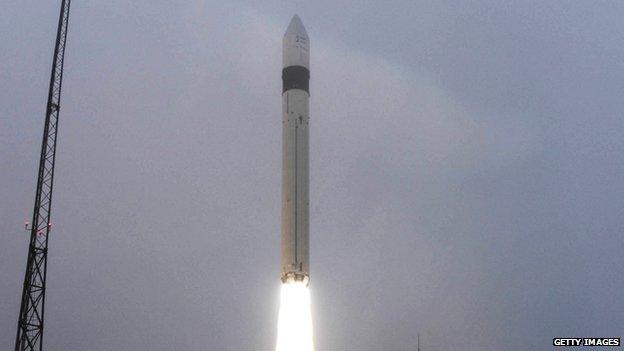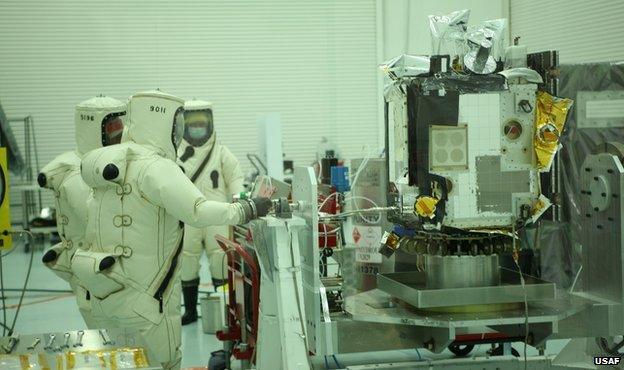Russia tests 'satellite catcher'
- Published

The three Rodnik satellites were sent into orbit on a Rockot launcher like this one
Russia may be testing a satellite capable of chasing down other orbiting spacecraft, observers say.
Such technology could be used for a wide variety of uses, including to repair malfunctioning spacecraft, but also to destroy or disable them.
The Kosmos 2499 satellite separated from the upper stage of its rocket in May and then chased it down.
The Russian mission follows similar on-orbit tests this year carried out by the US and China.
Kosmos 2499 was launched on 23 May 2014 as part of a seemingly routine mission to add new Rodnik communications satellites to an existing constellation.
Some previous Rodnik launches had carried a trio of spacecraft, but on this occasion a fourth object was released into orbit.
The US military initially classified the object as debris, but it then emerged that the Russian government had told the United Nations the launch had sent four satellites into orbit rather than three.
In the meantime, satellite observers had seen the object using engines to perform a series of unusual manoeuvres in space that changed its orbit.
These manoeuvres culminated on 9 November with a close approach to part of the rocket that originally launched the satellite into orbit.
According to satellite observer Robert Christy, who has been recording the craft's movements, Kosmos 2499 appears to have got to within a few tens of metres of the inactive Briz-KM rocket stage.
Close encounters
"I think this mission is a test, and you test these things with your own satellites, because if you do it with other peoples' they get upset. The Americans don't want bits of Russian hardware sitting alongside their satellites," Mr Christy told BBC News.
Mr Christy says he predicted this in August, tweeting "Cosmos 2499 - Maybe an inspector satellite? Its most probable target is the Briz-KM that launched it."
A satellite inspector is designed to sneak up on another satellite and photograph it or eavesdrop on its communications. But the same technology could also potentially be used to disable spacecraft - an anti-satellite weapon.

The US Air Force's ANGELS experimental satellite was also designed to manoeuvre close to a rocket stage
"The point is that each side sees the other can do it," said Mr Christy.
But the potential uses of such technology are not solely hostile - it could also be valuable to civilian satellite operators, allowing them to extend the lifetime of high-value assets in space through servicing, re-fuelling or repair on-orbit.
Though the mastery of such systems is highly desirable, it has proven extremely difficult in the past, with several failures.
Artificial intelligence
This year, both America and China have carried out tests similar to that carried out by Moscow.
On 28 July, the US Air Force launched, external an experimental satellite called ANGELS, external (short for Automated Navigation and Guidance Experiment for Local Space).
It was designed to manoeuvre around the upper stage of the Delta 4 rocket that had launched it into orbit with increasing degrees of automation and independence from human controllers on the ground. Sophisticated artificial intelligence systems are needed for such tasks.
The Chinese Shijian 15 satellite, external seems to be undertaking a similar task to that of Kosmos 2499. Launched on 19 July 2013, it has repeatedly approached and shadowed Shijian 7, an older Chinese satellite.
"The original satellite made some slight orbit adjustments, and then the other one copied them - keeping the distance the same. That suggests to me it's a test of rendezvous or chasing equipment. The satellite is probably self-controlling: if the target moves, it moves," said Mr Christy.
"The idea of the station-keeping is that if you're chasing my satellite, when you get near, I'll move it. So you've got to move at the same rate to catch up."
Intriguingly, another spacecraft launched on the same rocket as Shijian 15 may have used a robotic arm to release and then recapture a smaller companion satellite.
Such systems could potentially be used to disable spacecraft belonging to another state, but Mr Christy says China could be testing technology to be used by its space station, which is also set to use a robotic arm to grab modules in orbit.
Follow Paul on Twitter, external.